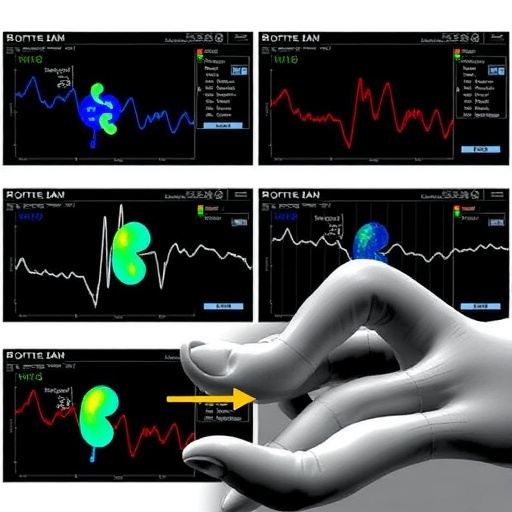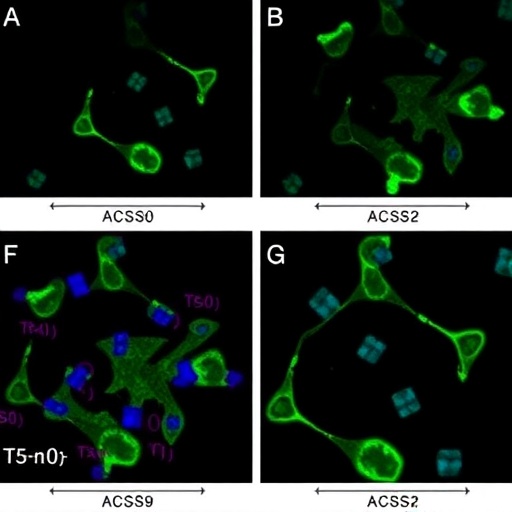In a groundbreaking development for neonatal care, researchers have unveiled pivotal insights into monitoring kidney oxygenation in preterm neonates using near-infrared spectroscopy (NIRS). This novel evaluation, led by Harer, Walker, Gadek, and colleagues, delves deeply into how kidney location, depth, and laterality influence the accuracy and reliability of oxygenation measurements in this vulnerable population. The findings promise to revolutionize critical care approaches for premature infants by enhancing real-time, non-invasive assessments of kidney health.
Preterm neonates often face significant challenges related to kidney function, primarily due to immature renal development and the heightened risk of hypoxic injury. Currently, clinicians rely on indirect markers or invasive methods to evaluate kidney oxygenation, hindering timely intervention. Near-infrared spectroscopy, a technique that measures tissue oxygen saturation by detecting light absorption differences between oxygenated and deoxygenated hemoglobin, offers a promising alternative. However, its application in neonatal kidney monitoring requires optimization, as fetal kidney position and tissue depth vary significantly, potentially affecting measurement fidelity.
The study systematically evaluated how the anatomical variations of kidneys in preterm infants influence NIRS signals. By carefully assessing differences in kidney laterality — that is, whether the monitored kidney is located on the right or left side — and the depth at which the kidney lies beneath the skin surface, the authors identified significant discrepancies in oxygen saturation readings. These discrepancies underscore the necessity of tailoring NIRS monitoring protocols to account for individual anatomical factors to avoid misleading clinical interpretations.
.adsslot_D5bkHWqRuT{ width:728px !important; height:90px !important; }
@media (max-width:1199px) { .adsslot_D5bkHWqRuT{ width:468px !important; height:60px !important; } }
@media (max-width:767px) { .adsslot_D5bkHWqRuT{ width:320px !important; height:50px !important; } }
ADVERTISEMENT
Methodologically, the research utilized a cohort of preterm neonates undergoing standard neonatal intensive care. Specialized NIRS sensors were positioned over the renal regions on both sides of the abdomen. The team employed advanced imaging modalities including ultrasound to ascertain kidney depth and spatial orientation. Correlating these physical parameters with NIRS data enabled the researchers to isolate the effects of kidney location and subcutaneous tissue thickness on oxygen saturation measurements.
One of the crucial observations was that kidneys positioned deeper within the abdominal cavity exhibited attenuated NIRS signals, primarily due to increased light scattering and absorption by overlying tissues. This finding reveals a fundamental limitation of the technique when applied without consideration of depth variation. Additionally, the study highlighted lateral differences, finding that one side often provided more reliable data—a discovery with direct clinical implications for sensor placement during monitoring.
Beyond spatial considerations, the temporal dynamics of kidney oxygenation were explored. The research documented how oxygenation levels vary with changes in systemic hemodynamics, respiratory support, and other clinical interventions common in the neonatal intensive care unit. By capturing these fluctuations with high temporal resolution, the team illustrated the potential of NIRS to serve as a continuous bedside monitoring tool, enabling clinicians to detect early signs of renal hypoxia and initiate prompt treatment.
Technically, the application of NIRS in preterm infants requires fine-tuning of sensor wavelength ranges and calibration algorithms. The optical properties of neonatal tissue differ significantly from adults’, necessitating bespoke device configurations. Harer et al. emphasize that standard adult or even pediatric NIRS systems may not provide accurate renal oxygenation data in neonates without adaptation. This insight calls for collaboration between biomedical engineers and clinicians to develop next-generation NIRS devices tailored specifically for neonatal renal monitoring.
The clinical implications of these findings extend far beyond the neonatal intensive care unit. Early, reliable kidney oxygenation monitoring may reduce the incidence of acute kidney injury (AKI), a condition linked to substantially increased morbidity and mortality in preterm infants. By integrating NIRS into routine neonatal monitoring protocols, healthcare teams gain a critical tool to detect renal risk early and guide fluid management, ventilation strategies, and pharmacologic interventions with greater precision.
Moreover, the study opens avenues for personalized medicine approaches in neonatology. Recognizing individual anatomical variability encourages the development of patient-specific monitoring plans, potentially incorporating 3D ultrasound mapping to inform NIRS sensor placement. Such personalized approaches could enhance the predictive power of oxygenation measurements and refine thresholds for clinical intervention.
Despite the promise, challenges remain in standardizing NIRS kidney monitoring globally. Variations in sensor design, calibration methods, and clinical protocols currently limit widespread adoption. Additionally, interpreting NIRS data requires careful consideration of confounding factors, such as skin pigmentation, subcutaneous fat, and the presence of edema. The study by Harer and colleagues provides a critical foundation for addressing these challenges through rigorous anatomical and physiological characterization.
Looking ahead, integrating NIRS monitoring with machine learning algorithms could revolutionize how clinicians interpret renal oxygenation data. Continuous data streams from NIRS sensors, combined with patient-specific anatomical parameters, could feed predictive models that alert providers to impending kidney injury before traditional signs emerge. Such proactive care would represent a paradigm shift in neonatal intensive care.
In summary, this research highlights the complex interrelationship between kidney anatomy and NIRS signal acquisition in preterm neonates, emphasizing the need for tailored approaches to achieve accurate, clinically meaningful oxygenation readings. The work stands as a testament to interdisciplinary collaboration, merging neonatal physiology, optical physics, and clinical technology to advance newborn care.
As the neonatal population continues to grow worldwide, innovations like these carry profound implications. Enhancing non-invasive monitoring capabilities not only improves immediate clinical outcomes but also supports long-term renal health and developmental trajectories in preterm infants. The pioneering insights from Harer, Walker, Gadek, and their team set a new standard for neonatal renal monitoring and beckon the broader scientific community to expand upon this fertile frontier.
Clinicians and biomedical engineers alike should anticipate further refinements in NIRS renal monitoring technology, with ongoing trials likely to validate and extend the findings presented here. Embracing such advancements may ultimately safeguard countless vulnerable infants from the hidden threat of renal hypoxia and its devastating sequelae.
The journey to reliable, point-of-care kidney oxygenation monitoring has entered an exciting phase, illuminated by this meticulous evaluation of anatomical and technical factors. By continuously refining our tools and approaches in concert with clinical insights, the vision of truly personalized neonatal renal care draws ever closer.
Subject of Research: Kidney oxygenation monitoring in preterm neonates using near-infrared spectroscopy.
Article Title: Evaluation of kidney oxygenation monitoring with near infrared spectroscopy in preterm neonates: kidney location, depth, and laterality differences.
Article References:
Harer, M.W., Walker, K., Gadek, L. et al. Evaluation of kidney oxygenation monitoring with near infrared spectroscopy in preterm neonates: kidney location, depth, and laterality differences. J Perinatol (2025). https://doi.org/10.1038/s41372-025-02358-2
Image Credits: AI Generated
DOI: https://doi.org/10.1038/s41372-025-02358-2
Tags: anatomical variations in neonatal kidneyshypoxic injury in preterm infantsimprovements in critical care for premature infantsmonitoring kidney oxygenationnear-infrared spectroscopy in neonatesneonatal critical care advancementsNIRS application in pediatric medicinenon-invasive techniques in neonatal careoxygen saturation measurement techniquespreterm infant renal health assessmentreal-time kidney health monitoringrenal development challenges in neonates





